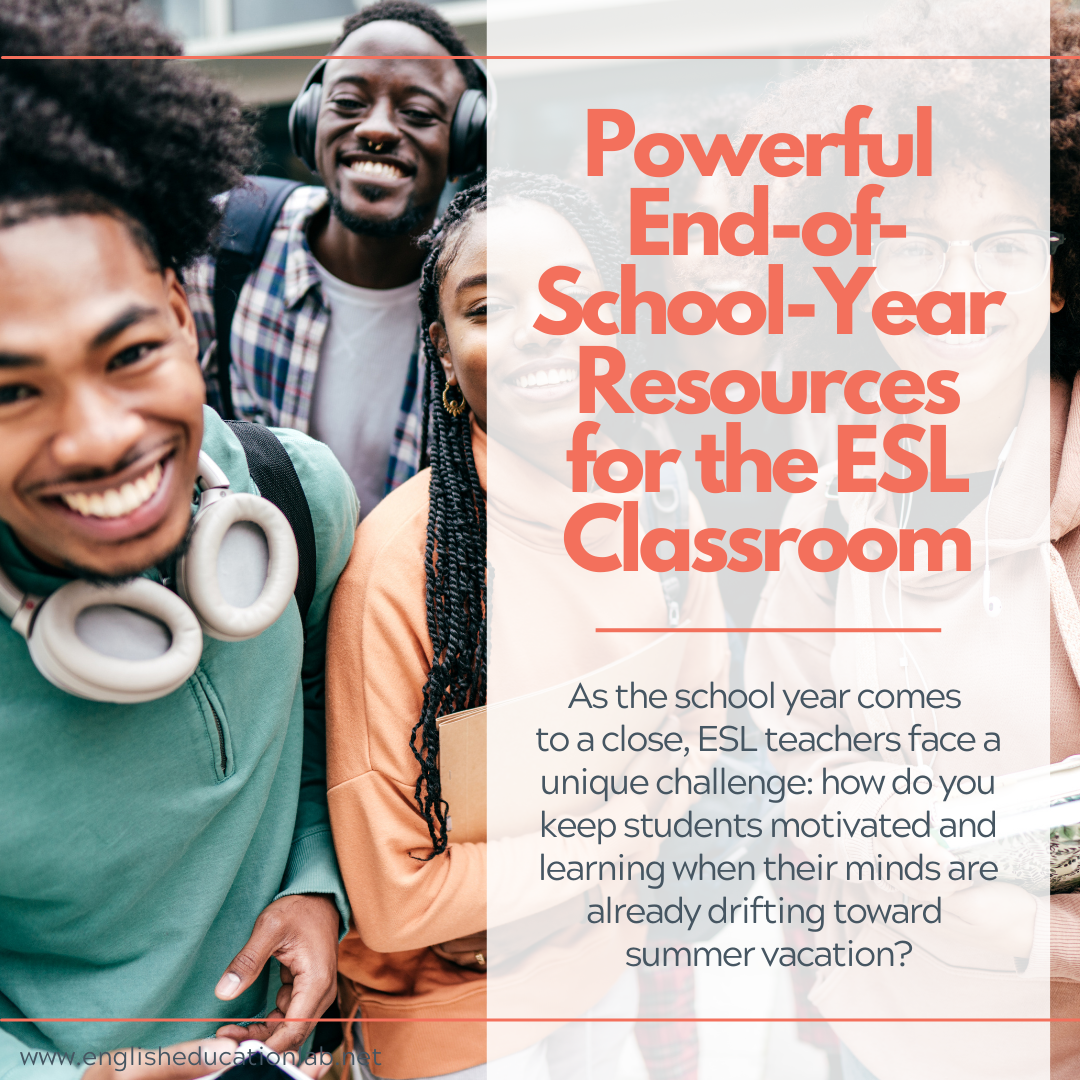
Essential ESL resources to enhance classroom discussions
Looking to enhance your ESL classroom conversations? Look no further. In this article, we have rounded up a selection of must-have ESL resources for teachers seeking to boost class interactions and foster meaningful discussions. Whether you are a seasoned educator or new to the ESL teaching scene, these tools are designed to engage your students and encourage language fluency. 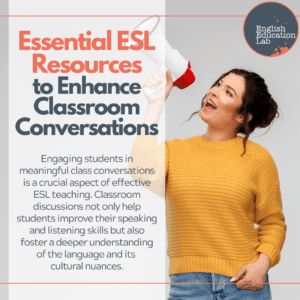
From conversation prompts and discussion starters to interactive online platforms, these resources are guaranteed to get your students excited about speaking English! With a focus on building confidence and improving communication skills, you can expect lively and engaging classroom conversations that will benefit all language learners.
Say goodbye to hours spent searching for suitable materials and hello to our curated list of ESL resources. This article will equip you with a variety of options to suit different language levels, teaching styles, and classroom dynamics. Get ready to take your ESL classes to the next level and watch your students become more confident and proficient speakers of English.
Importance of class conversations in ESL teaching
Engaging students in meaningful class conversations is a crucial aspect of effective ESL (English as a Second Language) teaching. Classroom discussions not only help students improve their speaking and listening skills but also foster a deeper understanding of the language and its cultural nuances. When students actively participate in conversations, they have the opportunity to practice their vocabulary, grammar, and pronunciation in a natural and interactive setting.
Fostering class conversations is particularly important for ESL learners, as it allows them to apply their language knowledge in real-world scenarios. Through discussions, students can gain confidence in their ability to communicate, overcome their fear of making mistakes, and develop the fluency needed to thrive in English-speaking environments. Furthermore, class conversations encourage critical thinking, problem-solving, and the exchange of ideas, all of which are essential skills for academic and professional success.
By prioritizing class conversations in ESL teaching, educators can create a dynamic and engaging learning environment that caters to the diverse needs and learning styles of their students. When students feel comfortable and encouraged to express their thoughts and opinions, they are more likely to actively participate, leading to deeper language acquisition and a stronger sense of community within the classroom.
Challenges faced by ESL teachers in promoting class conversations
While the importance of class conversations in ESL teaching is well-established, ESL teachers often face a variety of challenges in promoting and sustaining meaningful discussions in the classroom. One of the primary obstacles is the varying language proficiency levels of students, which can make it difficult to facilitate conversations that are accessible and engaging for all participants.
Another common challenge is the cultural and linguistic backgrounds of ESL students, which can influence their communication styles, comfort levels, and willingness to participate in class discussions. Some students may come from educational systems that emphasize rote learning and passive classroom participation, making it challenging for them to adapt to the more interactive nature of ESL teaching.
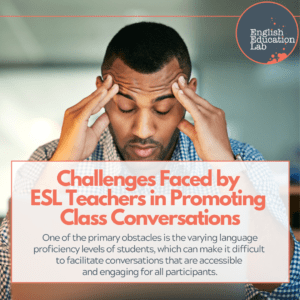
Additionally, ESL teachers must navigate the balance between providing enough scaffolding and support to encourage participation, while also allowing students to take ownership of the conversation and develop their language skills independently. Maintaining a positive and inclusive classroom environment, where students feel safe to take risks and make mistakes, is crucial for fostering meaningful class discussions.
Despite these challenges, ESL teachers can leverage a variety of strategies and resources to promote class conversations and help their students become confident and proficient English communicators. By understanding the unique needs and learning styles of their students, ESL teachers can create a supportive and engaging classroom environment that encourages active participation and language development.
Role-play activities for stimulating class conversations
One effective approach to stimulating class conversations in the ESL classroom is the use of role-play activities. Role-play exercises provide students with the opportunity to practice their language skills in realistic, contextual scenarios, allowing them to apply their knowledge in a safe and supportive environment.
Role-play activities can be designed to cover a wide range of topics and situations, from everyday interactions like ordering at a restaurant or making a doctor’s appointment, to more complex scenarios such as job interviews or business negotiations. By assuming different roles and perspectives, students can develop their communication skills, improve their vocabulary, and gain a deeper understanding of cultural nuances and social conventions.
To ensure that role-play activities are effective in promoting class conversations, ESL teachers can provide clear instructions, set realistic parameters, and offer guidance and feedback throughout the activity. Encouraging students to use the target language exclusively and providing opportunities for reflection and discussion after the role-play can further enhance the learning experience.
By incorporating role-play activities into their lesson plans, ESL teachers can create a dynamic and engaging classroom environment that fosters active participation, boosts student confidence, and ultimately leads to more meaningful and productive class conversations.
Conversation starters and icebreaker activities for ESL classes
Effective ESL teaching not only requires well-planned lessons but also the ability to create a positive and inclusive classroom atmosphere that encourages students to engage in conversations. One way to achieve this is through the use of conversation starters and icebreaker activities.
Conversation starters are short, open-ended questions or prompts that help initiate discussions and get students talking. These can range from simple inquiries about students’ interests, hobbies, or weekend plans, to more thought-provoking questions that encourage students to share their opinions, experiences, or perspectives on various topics. By starting with low-stakes, familiar topics, ESL teachers can help students feel more comfortable and confident in expressing themselves. If you are looking for no-prep, thought-provoking conversation starters make sure you visit our teacher’s shop.
Icebreaker activities, on the other hand, are designed to help students get to know each other better and create a sense of community within the classroom. These activities can involve sharing personal information, playing word games, or completing collaborative tasks. Icebreakers not only help students feel more at ease with their classmates but also provide opportunities for them to practice their English in a relaxed and supportive environment.
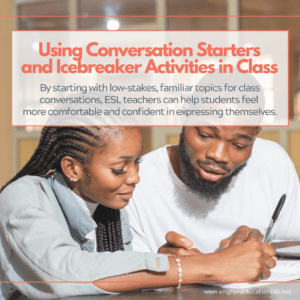
By incorporating conversation starters and icebreaker activities into their lessons, ESL teachers can set the stage for more engaging and productive class discussions. These techniques help students overcome their initial hesitation, build rapport with their peers, and develop the confidence and language skills necessary for meaningful conversations.
Using multimedia resources to enhance class conversations
In the digital age, ESL teachers have access to a wealth of multimedia resources that can be leveraged to enhance class conversations and engage students in the learning process. From videos and podcasts to interactive online platforms, these tools can bring a new level of dynamism and interactivity to the ESL classroom.
Videos, for example, can be used to introduce new vocabulary, demonstrate language in context, or spark discussions on cultural topics. By watching and discussing relevant video content, students can improve their listening comprehension, expand their vocabulary, and gain a deeper understanding of the nuances of the English language.
Podcasts, on the other hand, offer ESL students the opportunity to practice their listening skills and exposure to diverse accents and speaking styles. Teachers can incorporate podcast episodes into their lesson plans, using them as a springboard for class discussions or as a basis for comprehension and language exercises.
In addition to these traditional multimedia resources, ESL teachers can also leverage interactive online platforms and apps to facilitate class conversations. These tools, such as virtual whiteboards, discussion forums, and collaborative writing spaces, allow students to engage with the material and with each other in real-time, fostering a more dynamic and engaging learning experience.
By incorporating a variety of multimedia resources into their teaching strategies, ESL educators can create a more immersive and engaging learning environment that caters to different learning styles and preferences. This, in turn, can lead to more meaningful and productive class conversations, as students feel empowered to share their thoughts, ideas, and experiences using the tools and resources at their disposal.
Online platforms and websites for ESL conversation practice
In the digital age, ESL teachers have access to a wide range of online platforms and websites that can be leveraged to provide their students with additional opportunities for conversation practice. These resources offer a variety of interactive features and activities that can supplement and enhance the in-class learning experience.
One popular online platform for ESL conversation practice is language learning apps like Duolingo, Babbel, or Rosetta Stone. These apps offer a gamified approach to language learning, with interactive exercises, conversations, and lessons that can help students improve their speaking, listening, and comprehension skills. Many of these apps also include features that allow students to connect with native speakers or language partners for real-time practice.
Another valuable resource for ESL conversation practice is online discussion forums and chat rooms, such as those found on platforms like Reddit’s r/ESLTeaching or the TEFL.com forums. These spaces provide students with opportunities to engage in written conversations with other language learners and practitioners, allowing them to practice their writing and communication skills in a more casual and authentic setting.
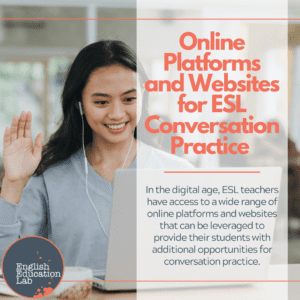
For ESL teachers looking to incorporate more multimedia elements into their conversation practice, there are also websites like TED Talks, which offer a vast library of engaging, thought-provoking videos on a wide range of topics. Teachers can use these videos as conversation starters, prompting students to discuss the content, share their perspectives, and practice their speaking skills.
By integrating these online resources into their teaching strategies, ESL educators can provide their students with additional avenues for conversation practice, reinforcing the language skills they develop in the classroom and fostering a more well-rounded and engaging learning experience.
ESL conversation games and activities for all levels
Engaging ESL students in meaningful class conversations can be a challenging task, particularly when dealing with learners of varying language proficiency levels. One effective approach to addressing this challenge is the incorporation of ESL conversation games and activities- a valuable category of ESL resources for teachers—into the classroom..
These interactive exercises not only help to break the ice and create a more relaxed and enjoyable learning environment but also provide students with opportunities to practice their speaking and listening skills in a low-stakes, supportive setting. From simple icebreakers and information-gap activities to more complex role-playing scenarios and debate-style discussions, there is a wealth of conversation-focused games and activities that can be tailored to suit the needs and abilities of ESL students at all levels.
For beginners, ESL teachers might consider implementing activities such as “Find Someone Who,” where students mingle and ask each other questions to find classmates who match certain criteria, or “Describe and Draw,” in which students take turns describing an object or image while their partner tries to recreate it. These types of activities encourage students to practice basic conversational skills, such as asking and answering questions, while also building rapport and fostering a sense of community within the classroom.
As students progress in their language proficiency, ESL teachers can introduce more complex conversation games and activities that challenge them to engage in more extended and nuanced discussions. Examples might include “Role-Play Scenarios,” where students act out real-world situations, or “Debate Club,” where students research and argue different sides of a controversial issue. These activities not only improve students’ fluency and vocabulary but also cultivate critical thinking and problem-solving skills that are essential for effective communication.
By incorporating a diverse range of ESL conversation games and ESL resources for teachers into their teaching repertoire, educators can create a dynamic and engaging learning environment that caters to the unique needs and learning styles of their students, ultimately leading to more meaningful and productive class discussions.
Using authentic materials to spark class conversations
In the ESL classroom, the use of authentic materials can be a powerful tool for sparking engaging class conversations and enhancing the learning experience for students. Authentic materials, such as news articles, podcasts, TV shows, or literary works, are resources that have been created for native speakers, rather than specifically for language learning purposes.
By incorporating authentic materials into their lessons, ESL teachers can expose their students to real-world language use, idiomatic expressions, and cultural references, providing them with a more immersive and realistic learning environment. This, in turn, can lead to more meaningful and substantive class discussions, as students grapple with the nuances and complexities of the language in context.
For example, teachers might use a news article about a current event as a springboard for a class discussion, prompting students to share their thoughts, opinions, and personal experiences related to the topic. Alternatively, they might use an excerpt from a literary work to explore themes of identity, relationships, or social issues, encouraging students to engage in thoughtful and insightful conversations.
Using authentic materials not only fosters class discussions but also supports language growth by exposing learners to a wider range of vocabulary, grammar structures, and communication styles. These types of ESL resources for teachers help students develop a deeper understanding of the language and its cultural contexts, ultimately making them more confident and capable communicators.
To ensure that the use of authentic materials is effective in promoting class conversations, ESL teachers should carefully select resources that are appropriate for their students’ language levels and interests, and provide the necessary scaffolding and support to help them navigate the content and engage in meaningful discussions.
Incorporating debate and discussion topics in ESL lessons

Engaging ESL students in debate and discussion-based activities can be a highly effective way to promote class conversations and enhance language learning. By encouraging students to research, analyze, and articulate their perspectives on a range of thought-provoking topics, ESL teachers can create a dynamic and stimulating learning environment that fosters critical thinking, communication skills, and cultural awareness.
Debate and discussion-based activities can be incorporated into ESL lessons in a variety of ways, from structured debates on controversial issues to more open-ended discussions on topics of personal or societal relevance. For example, teachers might ask students to research and argue different sides of a political or social debate, or they might facilitate a discussion on the impact of technology on modern life, encouraging students to share their experiences and opinions.
By engaging in these types of activities, ESL students not only have the opportunity to practice their speaking and listening skills but also develop a deeper understanding of the nuances of the English language, including the use of persuasive language, rhetorical devices, and cultural references. Additionally, debate and discussion-based activities can help to foster a sense of community within the classroom, as students learn to respectfully engage with and consider the perspectives of their peers.
To ensure that debate and discussion-based activities are effective in promoting class conversations, ESL teachers should provide clear guidelines and scaffolding, offer opportunities for research and preparation, and create a supportive and inclusive learning environment. By doing so, they can empower their students to become confident and articulate communicators, capable of engaging in meaningful and substantive conversations in English. For no-prep debate resources to use in your classroom, visit our teacher’s shop.
Meaningful class conversations are essential for effective ESL teaching. They help students build language skills, boost confidence, and understand cultural nuances in English. ESL teachers can use a variety of resources, strategies, and interactive activities to create dynamic learning environments. These environments promote active participation and support language development.
From role-play exercises and conversation starters to multimedia resources and online platforms, the tools and techniques explored in this article provide ESL educators with a comprehensive toolkit for promoting class conversations and enhancing the overall learning experience for their students. By incorporating these approaches into their teaching practices, ESL teachers can help their students become more confident, fluent, and effective communicators, better equipped to navigate the challenges and opportunities of the English-speaking world.
Ultimately, the impact of class conversations on ESL learning is far-reaching, as it not only improves language proficiency but also fosters critical thinking, problem-solving, and intercultural communication skills – all of which are essential for academic, professional, and personal success. By prioritizing class conversations in their ESL classrooms, educators can empower their students to become active and engaged language learners, ready to take on the challenges and opportunities that lie ahead.
Struggling to get your ESL students talking? We’ve got you covered! Download our FREE ESL teacher’s survival kit now and transform your ESL lessons into dynamic, student-led conversations!
Subscribe to my YouTube Channel!
Further Reading
5 Exciting ESL teaching materials to take your classroom to the next level
Unleashing your potential through learning English as a second language
What kind of online English courses are best for me?
Demystifying the present perfect tense: From confusion to clarity
Social media slang: Boost your online communication skills with these must-know terms

